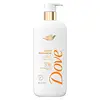What's inside
What's inside
 Key Ingredients
Key Ingredients

 Benefits
Benefits

 Concerns
Concerns

 Ingredients Side-by-side
Ingredients Side-by-side

Water
Skin ConditioningCocamidopropyl Betaine
CleansingSodium C16 Olefin Sulfonate
EmulsifyingCocos Nucifera Water
MaskingCandida Bombicola/Glucose/Methyl Rapeseedate Ferment
AntimicrobialSodium Hyaluronate
HumectantNiacinamide
SmoothingOlea Europaea Fruit Oil
MaskingLithospermum Erythrorhizon Root Extract
Skin ConditioningHelianthus Annuus Seed Oil
EmollientGlycyrrhiza Uralensis Root Extract
Skin ConditioningArgania Spinosa Kernel Oil
EmollientAngelica Gigas Root Extract
Skin ConditioningSodium PCA
HumectantManganese PCA
HumectantAscorbyl Glucoside
AntioxidantMagnesium PCA
HumectantZinc PCA
HumectantPhenoxyethanol
PreservativeSodium Cocoyl Isethionate
CleansingSodium Benzoate
MaskingPEG-150 Distearate
EmulsifyingTetrasodium Glutamate Diacetate
Water, Cocamidopropyl Betaine, Sodium C16 Olefin Sulfonate, Cocos Nucifera Water, Candida Bombicola/Glucose/Methyl Rapeseedate Ferment, Sodium Hyaluronate, Niacinamide, Olea Europaea Fruit Oil, Lithospermum Erythrorhizon Root Extract, Helianthus Annuus Seed Oil, Glycyrrhiza Uralensis Root Extract, Argania Spinosa Kernel Oil, Angelica Gigas Root Extract, Sodium PCA, Manganese PCA, Ascorbyl Glucoside, Magnesium PCA, Zinc PCA, Phenoxyethanol, Sodium Cocoyl Isethionate, Sodium Benzoate, PEG-150 Distearate, Tetrasodium Glutamate Diacetate
Water
Skin ConditioningCocamidopropyl Betaine
CleansingGlycerin
HumectantAcrylates Copolymer
Sodium Benzoate
MaskingSodium Lauroyl Isethionate
CleansingSodium Methyl Lauroyl Taurate
CleansingHydrated Silica
AbrasiveLauric Acid
CleansingSodium Chloride
MaskingParfum
MaskingHydrogenated Vegetable Glycerides
EmollientStearic Acid
CleansingPalmitic Acid
EmollientHydroxystearic Acid
CleansingGlyceryl Stearate
EmollientAscorbic Acid
AntioxidantJojoba Esters
EmollientCocamide Mea
EmulsifyingCapryloyl Glycine
CleansingUndecylenoyl Glycine
CleansingCitric Acid
BufferingZinc Oxide
Cosmetic ColorantCI 77491
Cosmetic ColorantCI 77492
Cosmetic ColorantCitronellol
PerfumingGeraniol
PerfumingHexyl Cinnamal
PerfumingLinalool
PerfumingWater, Cocamidopropyl Betaine, Glycerin, Acrylates Copolymer, Sodium Benzoate, Sodium Lauroyl Isethionate, Sodium Methyl Lauroyl Taurate, Hydrated Silica, Lauric Acid, Sodium Chloride, Parfum, Hydrogenated Vegetable Glycerides, Stearic Acid, Palmitic Acid, Hydroxystearic Acid, Glyceryl Stearate, Ascorbic Acid, Jojoba Esters, Cocamide Mea, Capryloyl Glycine, Undecylenoyl Glycine, Citric Acid, Zinc Oxide, CI 77491, CI 77492, Citronellol, Geraniol, Hexyl Cinnamal, Linalool
 Reviews
Reviews

Ingredients Explained
These ingredients are found in both products.
Ingredients higher up in an ingredient list are typically present in a larger amount.
Cocamidopropyl Betaine is a fatty acid created by mixing similar compounds in coconut oil and dimethylaminopropylamine, a compound with two amino groups.
This ingredient is a surfactant and cleanser. It helps gather the dirt, pollutants, and other impurities in your skin to be washed away. It also helps thicken a product and make the texture more creamy.
Being created from coconut oil means Cocamidopropyl Betaine is hydrating for the skin.
While Cocamidopropyl Betaine was believed to be an allergen, a study from 2012 disproved this. It found two compounds in unpure Cocamidopropyl Betaine to be the irritants: aminoamide and 3-dimethylaminopropylamine. High-grade and pure Cocamidopropyl Betaine did not induce allergic reactions during this study.
Learn more about Cocamidopropyl BetaineSodium Benzoate is a preservative. It's used in both cosmetic and food products to inhibit the growth of mold and bacteria. It is typically produced synthetically.
Both the US FDA and EU Health Committee have approved the use of sodium benzoate. In the US, levels of 0.1% (of the total product) are allowed.
Sodium benzoate works as a preservative by inhibiting the growth of bacteria inside of cells. It prevents the cell from fermenting a type of sugar using an enzyme called phosphofructokinase.
It is the salt of benzoic acid. Foods containing sodium benzoate include soda, salad dressings, condiments, fruit juices, wines, and snack foods.
Studies for using ascorbic acid and sodium benzoate in cosmetics are lacking, especially in skincare routines with multiple steps.
We always recommend speaking with a professional, such as a dermatologist, if you have any concerns.
Learn more about Sodium BenzoateWater. It's the most common cosmetic ingredient of all. You'll usually see it at the top of ingredient lists, meaning that it makes up the largest part of the product.
So why is it so popular? Water most often acts as a solvent - this means that it helps dissolve other ingredients into the formulation.
You'll also recognize water as that liquid we all need to stay alive. If you see this, drink a glass of water. Stay hydrated!
Learn more about Water